The 2013 MacBook Air Review (13-inch)
by Anand Lal Shimpi on June 24, 2013 12:01 AM ESTThe GPU: Intel HD 5000 (Haswell GT3)
Hire enough ex-ATIers and you’ll end up really caring about GPU performance apparently. It’s good to see that Apple still views increasing GPU performance as non-negotiable, even at the MacBook Air level. Discrete GPUs are out of the question in the MacBook Air, so all models ship with Intel’s on-die processor graphics. More importantly, all CPU choices integrate the largest GPU offering: Intel’s HD 5000 (aka GT3).
Clock speeds alone prevent the 40 EU GPU implementation from being called an Iris 5100. Given the 15W TDP limit, Intel wouldn’t be able to do the Iris name justice even if it tried.
It’s hilarious that Intel refused to give out die photos for anything other than quad-core Haswell GT2, citing competitive concerns, yet at Apple’s WWDC launch of the new MacBook Airs we got to see the first die shot of a dual-core Haswell GT3. Update: I stand corrected. Intel posted its own shot here.
From the die photo it’s very obvious that like the quad-core Haswells with Iris Pro, the dual-core GT3 parts are over half GPU. Here's the only Haswell die shot Intel PR officially released by comparison, a quad-core GT2 part that's mostly made up of CPU cores:
Similar to the CPU discussion, on the GPU front Haswell has to operate under more serious thermal limits than with Ivy Bridge. Previously the GPU could take the lion’s share of a 17W TDP with 16 EUs, now it has 15W to share with the PCH as well as the CPU and 2.5x the number of EUs to boot. As both chips are built on the same 22nm (P1270) process, power either has to go up or clocks have to come down. Intel rationally chose the latter. What you get from all of this is a much larger GPU, that can deliver similar performance at much lower frequencies. Lower frequencies require lower voltage, which in turn has a dramatic impact on power consumption.
Take the power savings you get from all of this machine width, frequency and voltage tuning and you can actually end up with a GPU that uses less power than before, while still delivering incrementally higher performance. It’s a pretty neat idea. Lower cost GPUs tend to be smaller, but here Intel is trading off die area for power - building a larger GPU so it can be lower power, instead of just being higher performance.
| A Historical Look at MacBook Air GPU Performance | |||||||||
| 2011 | 2012 | 2013 | |||||||
| GPU | Intel HD 3000 | Intel HD 4000 | Intel HD 5000 | ||||||
| Manufacturing Process | 32nm | 22nm | 22nm | ||||||
| Frequency | 350/1150MHz | 350/1050MHz | 200/1000MHz | ||||||
| Cores | 12 | 16 | 40 | ||||||
| Peak GFLOPS | 165.6 GFLOPS | 268.8 GFLOPS | 640 GFLOPS | ||||||
| TDP | 17W | 17W | 15W | ||||||
This is an even bigger deal because few of the other OEMs seem interested in paying for the larger die. Acer’s S7 uses Intel’s HD 4400 (Haswell GT2, 20 EUs), as do most of the other Haswell Ultrabooks that have been announced thus far. Armed with a 2011, 2012 and 2013 MacBook Air as well as Acer’s 2nd generation S7, we now have the ability to compare everything from Intel’s HD 3000 (Sandy Bridge) all the way up to HD 5000. It’s important to keep in mind that with the exception of HD 3000, everything here is built on the same 22nm process, and with HD 4400/5000 TDPs actually went down. In other words, post Ivy Bridge, any GPU performance gains were very hard to come by.
I’m splitting up the GPU performance data into three sections. The first is a look at some games/settings that are actually playable on processor graphics. The second is comparison data for laptop Bench. The deltas here are academic at best since nothing slower than Iris Pro can really deliver playable frame rates in our high-end notebook GPU tests. The final section focuses on synthetic performance, which should help characterize the peak theoretical gains you can expect from HD 5000.
All of the gaming tests were run under Boot Camp/Windows 8. I think it’s time to retire the HL2/Portal testing under OS X.
Playable Gaming Performance
There's a surprising number of games that are actually playable on Intel's HD 5000 in the MacBook Air. You have to be ok with the fan spinning quite loudly, but it's possible to get some ultra portable gaming in if you're up for it.
For all of these tests I stuck with 1366 x 768 so I could run comparable data on the only HD 3000 equipped MBA I had, an 11-inch model. I also threw in data from Inte's HD 4400 using the new Haswell equipped Acer S7. I'll start with GRID 2, a brand new racer, running at relatively low quality settings.
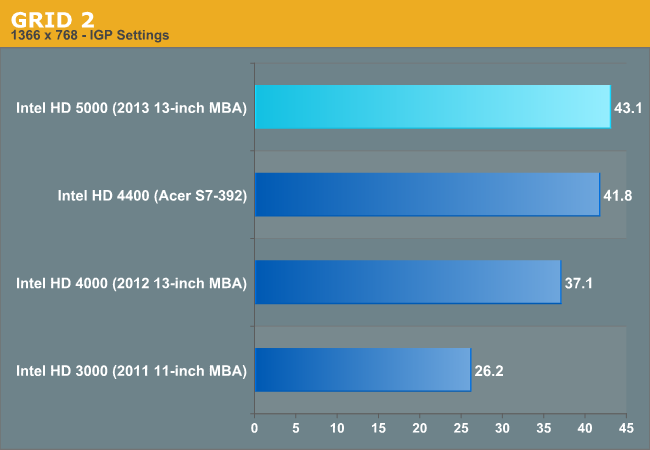
GRID 2 is absolutely playable on the new MacBook Air. At 43.1 fps it's 16% faster than last year's HD 4000 model. A 16% gain without increasing TDP on the same manufacturing process is pretty impressive. The gains over the 2011 MBA are substantial. GRID 2 goes from almost playable to fast enough where you can actually turn up some of the quality settings if you wanted to.
Next up is Borderlands 2. Again, a fairly modern title, but one that's really optimized for current generation consoles - making high-end processor graphics more than up for the task. While a higher TDP implementation of Haswell's integrated graphics wouldn't have an issue here, things are a little more difficult with a 15W TDP.
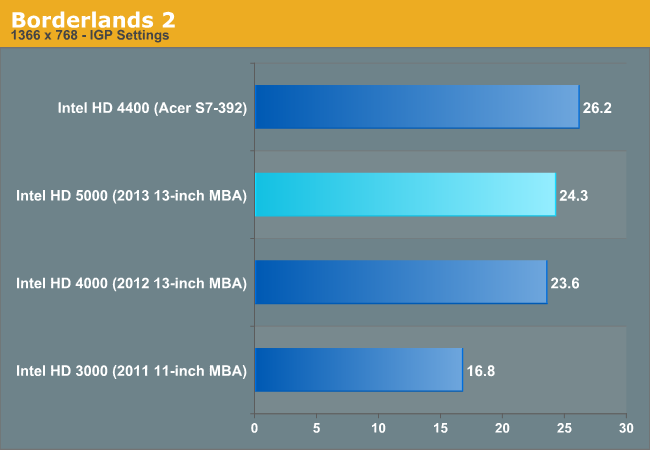
We see a marginal improvement over the HD 4000, we're clearly thermally bound at this point. What's interesting is the HD 4400 on the S7 is actually quicker here. The difference could be cooling or how Apple decides to scale back on GPU frequency when faced with thermal limits. A quick look at Haswell's power reporting confirms that while running my Borderlands 2 test the GPU was already exceeding the PL1 (Power Limit 1) of 15W:

Remember, with Sandy Bridge Intel introduced Turbo Boost 2.0 that effectively allowed for two separate power limits - one equal to the processor's TDP (PL1) and one higher than the processor's TDP (PL2) that could be hit as long as the die temperature doesn't get too high.
Despite the sub 30fps frame rate in this benchmark, Borderlands 2 was definitely playable on the HD 5000. It wasn't always smooth but if you need your single player fix, it'll suffice.
I've had a few requests to bring back our Minecraft benchmark. We ditched it from our higher end GPU reviews since it's no longer stressful enough, but for 15W TDP iGPUs it's perfect.
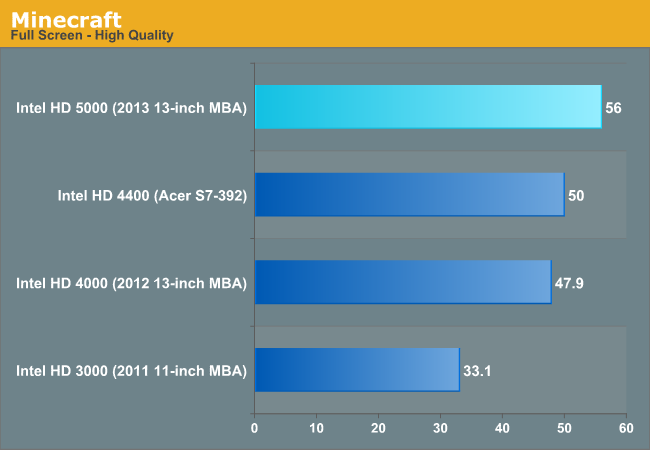
Once again we see almost a 17% increase over Intel's HD 4000. The HD 4400 comparison is also very impressive with a 12% increase in performance vs. what most MBA competitors will be using.
When I was a kid all I wanted was a console that could play arcade quality ports of Street Fighter II and Mortal Kombat II. These days, even the latest Street Fighter title has no issue playing on free graphics:
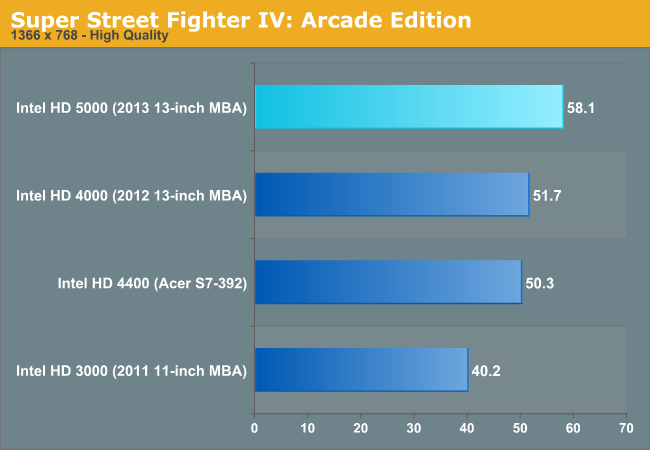
16% seems to be the magic number as that's exactly how much faster HD 5000 is compared to HD 4000. Given the lower TDP this year, that's a pretty reasonable gain. Looking at the sheer number of transistors that had to be used to get there however gives you good insight into just how hard it is to improve performance without a corresponding process node shrink.



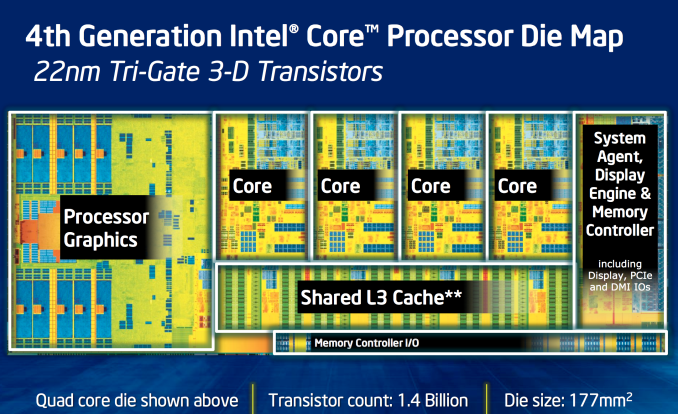
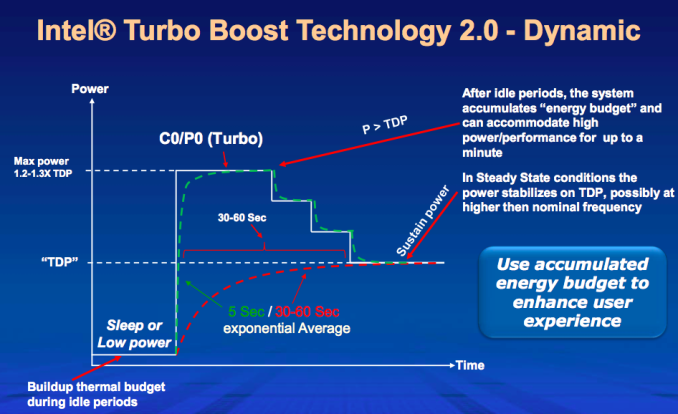








233 Comments
View All Comments
vol7ron - Wednesday, June 26, 2013 - link
I'm sorry, have you ever owned an MBA? You don't want to be doing any heavy development on this device, it will get hot fast.This device should be the Traveler's Laptop: good enough to carry with you, more productive than an iPad, full keyboard, longer battery life than a regular laptop, lighter weight, and a few ports to maybe support what you need. It would be perfect for a plane or train, maybe to lounge by the pool, but should not be considered as a desktop or MBP replacement.
The shame of it is that it's so portable, that it leaves you wanting to do more with it. It almost has done it's job too well. In that regard, you are right, it is lacking the things that would put it over the edge, that would make it a replacement of the desktop/MBP, which again it's not. But be conscious that [I think] this has no fans, and from when I used it, got hot really fast -- horrible for any extreme development, or even long-term gaming.
darwinosx - Monday, July 8, 2013 - link
Hah! Lots of developers use Airs without issue.cscordo - Thursday, August 8, 2013 - link
What a ridiculous comment from someone who clearly doesn't develop software.I'm still on a 13" MBA from two gens ago and run multiple IDE's and SQL Server 2010, and it doesn't skip a beat.
What type of "heavy" software development do you perform that it can't handle? I'd be very interested to know.
josef195 - Tuesday, August 20, 2013 - link
So, you're saying the Macbook Air isn't for pro users? I must say, if only they had some Macbook for professional users; they could even call it a Macbook Pro.Calista - Thursday, June 27, 2013 - link
I agree with your ideas of adding the option of 16 GB of RAM and 4G support. Virtualization is growing all the time, the memory usage can grow very quickly if starting to run a few VM in parallel. And not having the option of 4G in this day and age is just embarrassing. For a machine *built* to be used on the go, with every component (battery life, weight, size) adopted to this task not adding 3G/4G just doesn't make sense.Dave DeCo - Saturday, June 29, 2013 - link
I have never given much thought to the 4G thing. But now that it's brought up I too wonder why the MBA doesn't offer it. My incredibly portable iPad has it. iPhone too of course. Why not the wafer thin MacBook Air? Oh Apple. Always dangling that carrot on the longest stick possible while telling us we don't need carrots. If that last line makes sense to anyone please tell me. Because I don't know what the Helsinki I just said.australianm8 - Saturday, July 6, 2013 - link
A few considerations for everyone fussing about 4g support.1. Apple likes to keep a simple product line
2. Look at a teardown, not much room in there for much more to add. (already pushing it's thermal limits)
3. There are a plethora of cell carriers that offer 4g USB sticks
darwinosx - Monday, July 8, 2013 - link
That was a childish and ignorant display of petulance. Obviously a particularly immature teenager.jaycee1970 - Saturday, August 24, 2013 - link
"Dump your apple stock now, it will bounce back"Wow, that's fantastic financial advice, genius. I'll definitely sell something that will go up in value. The rest of your post was just as intelligent. Thank you.
othernet - Monday, November 4, 2013 - link
Uhm... there are hybrid notebook/tablets out there. Did you buy one? I don't know of anyone that did.Apple sells Retina 4, 10, 13 and 15 inch products. Soon, an 8 inch product too. You must have missed the keynotes.
Wireless charging? Wait, do you still need to plug the wireless charger somewhere to make it work? When it doesn't have to sign me up!